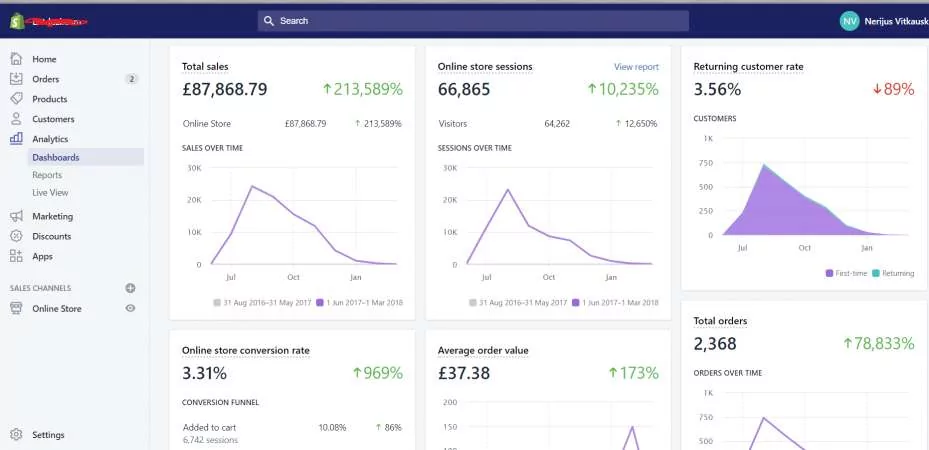Dropshipping – good or bad? Check out this Shopify dropshipping pros and cons before diving into a new dropshipping business.
The term ‘dropshipping’ has become synonymous with eCommerce in recent years and for a good reason. This business model offers many benefits compared to traditional retail methods. Dropshipping has become more popular as a low-risk way for entrepreneurs to launch an online business, thanks to platforms like Shopify.
If you’re considering starting a dropshipping business on Shopify, it’s essential to understand the pros and cons to make an informed decision. In this article, we’ll dive into the advantages and disadvantages of dropshipping on Shopify so you have a better understanding of what to expect from this business model.
Shopify – An Overview

Among the most popular e-commerce platforms in the world, Shopify powers the online storefronts of more than a million companies. It’s a user-friendly platform allowing individuals to create and manage online stores without technical or coding knowledge.
One of the main reasons for Shopify’s popularity is its seamless integration with dropshipping apps like Oberlo, making it an excellent choice for those who want to start a dropshipping business.
How Dropshipping Works With Shopify
One kind of retail fulfillment is “dropshipping,” which involves a store not owning its products. On the contrary, the store buys the item from an outside vendor and arranges for its direct shipment to the buyer. Because of this, conventional retail’s inventory management and initial investment requirements are moot.
You can automate importing products from suppliers and fulfilling orders with Shopify by connecting your online store to various dropshipping apps. This integration streamlines the process of running a dropshipping business, making it an appealing option for many entrepreneurs.
Furthermore, dropshipping allows for greater flexibility and location independence, making it an attractive choice for digital nomads and those who prefer remote work.
Is Dropshipping on Shopify Worth It?
Based on the statistics, it’s clear that dropshipping on Shopify is a popular choice for many e-commerce entrepreneurs. With over 12% of all Shopify stores utilizing at least one dropshipping product and 7% of all products available on the platform coming from dropshipping services, this business model is worth considering.
Entrepreneurs without technical expertise can easily set up and manage their online stores by integrating Shopify and various dropshipping apps. Plus, it is a great choice for people with little funds who want to start a business because there is little to no initial investment required, and the barrier to entry needs to be higher.
Before jumping headfirst into dropshipping, it is important to consider the benefits and drawbacks. While there are many benefits to this business model, such as flexibility and location independence, there are also challenges to consider, such as intense competition and potential quality control issues.

Shopify Dropshipping Pros and Cons – the Good and the Bad

While dropshipping offers many benefits, it’s essential to understand both the positives and negatives before committing to this business model. Let’s look at some of the advantages and challenges of dropshipping on Shopify.
Pros of Shopify Dropshipping
Low Initial Investment:
One of the most significant advantages of dropshipping on Shopify is the low initial investment required. Unlike traditional retail, you don’t need to purchase inventory upfront or manage a warehouse. This eliminates the risk of overstocking and allows for more flexibility in product selection.
Plus, business owners can launch an online store without emptying their bank accounts thanks to Shopify’s inexpensive monthly plans. The integration with dropshipping apps also eliminates the need for custom coding or technical knowledge, reducing additional costs.
Wide Selection of Products:
Another benefit of Shopify dropshipping is the vast selection of products available. Entrepreneurs are spoiled for choice when selecting products with millions of products available from thousands of suppliers. This paves the way for less financial risk when trying out new products and more leeway when choosing a niche.
Moreover, with various suppliers, entrepreneurs can also source products at competitive prices, potentially increasing profit margins. The dropshipping model allows easy scaling without inventory or storage capacity limitations.
Easy To Set Up:
Because of its intuitive design and compatibility with dropshipping apps, Shopify makes it easy to set up a store. With step-by-step guides and tutorials, even those without technical knowledge can create a professional-looking online store in hours.
Furthermore, Shopify offers 24/7 customer support, allowing entrepreneurs to get assistance whenever they encounter issues. The platform also provides various features to help with marketing, such as abandoned cart recovery and social media integration.
Location Independence:
One of the most significant advantages of dropshipping on Shopify is the ability to run a business anywhere. You only need an internet connection to run your online store and complete client orders.
This makes it an ideal option for those who prefer remote work or digital nomads who want to travel while running a business. It also eliminates the need for physical stores, reducing overhead costs and allowing entrepreneurs to focus on growing their businesses.
Scalability:
The dropshipping model allows for easy scalability, making it an attractive choice for entrepreneurs looking to grow their businesses. With no inventory or storage capacity limitations, you can easily add new products and expand your business without worrying about space constraints.
Furthermore, Shopify offers various plans and features designed specifically for scaling, such as abandoned cart recovery and bulk editing. With the ability to handle high order volumes, entrepreneurs can focus on increasing sales without worrying about logistics.
Reduced Risks:
One of the biggest advantages of dropshipping on Shopify is the reduced risks compared to traditional retail models. With no need to purchase inventory upfront, entrepreneurs can avoid the risk of overstocking and potentially losing money.
Furthermore, since products are shipped directly from suppliers, there’s no need to worry about managing a warehouse or shipping logistics. This also reduces the risk of damaged or lost inventory, saving entrepreneurs time and money.
Focus on Marketing and Sales:
Since suppliers handle the logistics of order fulfillment, entrepreneurs can focus on marketing and sales. This allows more time to grow the business and find new customers.
Dropshipping also eliminates the need for managing inventory, freeing up even more time for entrepreneurs to focus on other business areas. With Shopify’s various features designed to help with marketing and sales, entrepreneurs can quickly grow their online presence and increase their reach.
Access To Global Market:
With dropshipping on Shopify, entrepreneurs have access to a global market. With the ability to source products from suppliers worldwide and reach customers across the globe, there are no limitations on geographical boundaries.
This allows for more opportunities for growth and increased sales potential. Furthermore, with Shopify’s multi-currency support and international shipping options, it’s easier than ever to cater to customers in different countries.
Shopify Dropshipping Cons

While dropshipping on Shopify offers many benefits, it’s essential also to consider the potential challenges and disadvantages of this business model.
The Profit Margins May Be Lower:
One of the main disadvantages of dropshipping on Shopify is that profit margins may be lower compared to other business models. This is due to the additional costs involved, such as transaction fees and dropshipping app fees.
Moreover, since products are sourced from suppliers, there may also be less control over pricing and potential discounts. This has the potential to impact the company’s bottom line.
High Competition:
Competition has also increased as dropshipping on Shopify becomes a popular business model. With thousands of stores selling similar products, standing out and attracting customers may take time and effort.
This can make it difficult for new entrepreneurs to establish their online presence and gain market share. Therefore, it’s essential to have a unique selling proposition and a solid marketing strategy in place to compete effectively.
Reliance on Suppliers:
With dropshipping on Shopify, entrepreneurs rely heavily on their suppliers for product quality and timely order fulfillment. A supplier’s failure to meet expectations can reflect poorly on the online store and lead to negative reviews or customer complaints.
Furthermore, if a supplier suddenly goes out of business or changes their policies, it can significantly impact the dropshipping business. Therefore, it’s crucial to carefully research and choose reliable suppliers to ensure the online store’s success and reputation.
Shipping Times and Issues:
Since products are sourced from suppliers, customers may have longer shipping times than traditional retail models. This can lead to customer dissatisfaction and affect the online store’s reputation.
Moreover, lost or damaged shipments can also arise, causing delays and additional costs for entrepreneurs. It’s essential to clearly understand supplier policies and shipping times to manage customer expectations effectively.
Increased Customer Service Responsibilities:
With dropshipping on Shopify, entrepreneurs handle customer service inquiries and issues. This includes responding to questions about products, processing returns or exchanges, and addressing customers’ concerns.
This can be challenging for new entrepreneurs, who may need to gain experience in customer service or have the resources to manage multiple inquiries. However, with proper communication and efficient processes, entrepreneurs can navigate these responsibilities successfully. Shopify also offers various apps and tools to help manage customer inquiries and improve the overall customer experience.
Brand Control Challenges:
Since products are sourced from suppliers, it can take time to maintain brand control and consistency. With different suppliers offering similar products, there may be variations in product quality or packaging.
This can affect the overall image and perception of the brand, potentially leading to customer dissatisfaction. To combat this issue, entrepreneurs should carefully vet their suppliers and regularly monitor product quality to ensure consistency.
Additionally, it’s essential to have a clear brand identity and communicate this with suppliers to maintain consistency across all products. This may require more effort and resources, but it can greatly impact the success of dropshipping on Shopify.
Transaction Fees:
Every purchase made on Shopify incurs a transaction fee, which can eat into profit margins over time. However, these fees can be reduced by upgrading to a higher-priced plan or using Shopify Payments.
Furthermore, some dropshipping apps on Shopify also charge additional fees. Researching and comparing different options is essential to choose the most cost-effective solution for your business. With careful planning and management, transaction fees can be minimized and not significantly impact overall profitability.
Legal and Compliance Issues:
With an online business, there are various legal and compliance issues that entrepreneurs must adhere to. This includes product safety regulations, data protection laws, and consumer rights policies.
Penalties or the online store closure may result from noncompliance with these regulations. Therefore, it’s crucial to research and understand all applicable laws for the products sold and the target market.
Additionally, entrepreneurs may need to obtain necessary licenses or permits for their business. It’s important to consult with legal professionals and stay updated on any regulation changes to avoid potential issues.
FAQs about Shopify Dropshipping Pros and Cons

What are the disadvantages of Shopify dropshipping?
- Profit margins are lower than those of conventional retail models.
- Increased competition from other dropshippers and e-commerce businesses.
- Reliance on third-party suppliers for product quality and shipping times.
- Shipping issues such as longer delivery times and lost or damaged shipments
- Increased responsibility for customer service inquiries and issues.
- Challenges with maintaining brand control and consistency.
- Transaction fees for using the Shopify platform and dropshipping apps.
- Legal and compliance issues include product safety regulations and data protection laws.
What is the dark side of dropshipping?
The dark side of dropshipping includes challenges such as low profit margins, increased competition, shipping, and supplier issues, customer service responsibilities, brand control difficulties, transaction fees, and legal and compliance concerns. These factors can affect a dropshipping business’s overall success and profitability on Shopify.
Is Dropshipping a big risk?
The capacity to comprehend and handle the difficulties of dropshipping is the determining factor here. While certain risks are involved, such as lower profit margins and legal compliance issues, careful planning and management can mitigate these risks and lead to long-term success. It is important for entrepreneurs to thoroughly research and understand all aspects of dropshipping before starting their own business.
What is the hardest part of dropshipping?
One of the hardest parts of dropshipping is managing customer service inquiries and issues. As a dropshipper, you are responsible for handling all customer inquiries, complaints, and returns, which can be time-consuming and challenging. Maintaining brand control and consistency can also be difficult as products come from various suppliers with potential variations in quality or packaging.
Is Shopify good for beginners?
Yes, Shopify is popular for beginners due to its user-friendly interface and low startup costs. It also offers extensive resources and support for new entrepreneurs, making it easier to get started in the world of e-commerce. However, it’s important for beginners to thoroughly research and understand all aspects of dropshipping on Shopify before diving in to ensure success.
Get Started With Your Own Exclusive Prebuilt Shopify Dropshipping Store With Dropship Launchpad (FREE):
As a beginner, starting a dropshipping business on Shopify can be overwhelming. That’s why Dropship Launchpad offers an exclusive prebuilt Shopify store for free to help entrepreneurs get started in the world of dropshipping. The store comes with hand-picked products, marketing materials, and everything needed to start selling immediately. With this free launchpad, beginners can focus on learning and growing their business without the added stress of building a store from scratch. Visit dropshiplaunchpad.com to get started today!
Conclusion: Shopify Dropshipping Pros and Cons
Dropshipping on Shopify offers many advantages, such as low startup costs and flexibility, making it an attractive business model for entrepreneurs. On the flip side, there are several drawbacks, such as higher levels of competition, decreased profit margins, and problems with legal compliance. Dropshipping on Shopify comes with difficulties, but you can overcome them with careful preparation and management. Well-informed and ready entrepreneurs can overcome these obstacles and build a prosperous dropshipping business on Shopify. So, it’s essential to thoroughly research and prepare before jumping into the world of dropshipping on Shopify. Entrepreneurs can overcome these challenges and create a thriving online business with the right approach.

 Shopify Dropshipping: 2024’s Ultimate Key Insights
Shopify Dropshipping: 2024’s Ultimate Key Insights  What is Shopify Dropshipping: E-Commerce Solution in 2024
What is Shopify Dropshipping: E-Commerce Solution in 2024  How to Dropship on Shopify: 2024 Ultimate Success Playbook
How to Dropship on Shopify: 2024 Ultimate Success Playbook  Top Shopify Dropshipping Suppliers: 12 Best Partners in 2024
Top Shopify Dropshipping Suppliers: 12 Best Partners in 2024